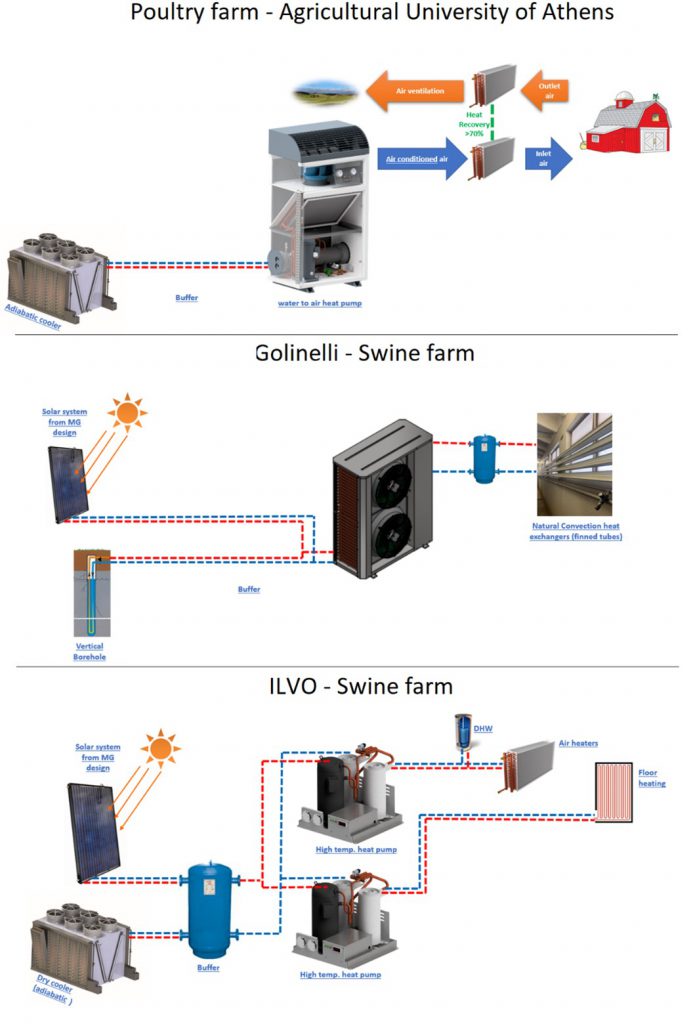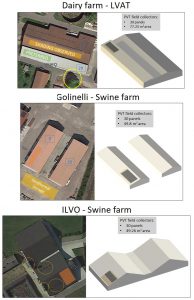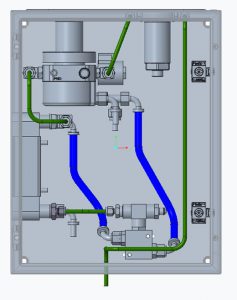As we are currently in the tenth month of RES4LIVE, the works of Work Package 1 (WP1) are on full development. WP1 focuses on the adaptation of innovative technologies so that to perfectly fit the condition and environment entailed by livestock farming. Promising Renewable Energy Sources (RES) technologies capable to greatly serve the vision of de-fossilising livestock farming are the:
- On farm production and upgrading of biogas to biomethane, by ATB
- Adaptation of a farm tractor for biomethane use, by CRMT
- Adaptation and testing of the flexible heat pump, by PSYCTOTHERM
- Development of PVT (Photovoltaic thermal collectors) system designs towards standardisation, by MG Sustainable
Up to now, the initial designs have been finalized, the expected performance and cost-related parameters have been confirmed.
1. On farm production and upgrading of biogas to biomethane
ATB has undertaken the task of upgrading a biogas plant to produce biomethane, utilizing the membrane separation technique. Through this, the biogas would be initially purified from H2S and then compressed to a higher pressure to allow its separation from CO2. Then, a clever sequence of separation stages combined with CO2 recovery will allow the 100% separation of methane. The recovery of CO2 facilitates the 100% CH4 separation from biogas and subsequently provides food safe CO2 that is produced with further compressing of the part containing CO2 after going through the membrane separation. The CO2 is subsequently liquefied, while non-condensable gases are separated within a downstream separator and conveyed again to the membrane unit. A schematic overview of the initial design for the biogas upgrading unit in LVAT pilot farm, is provided in Figure 1.

The plant layout and an indicative positioning of measurement equipment is presented in Figure 2.

The main performance parameters of the biogas upgrading unit can be summarized as follows:
Biomethane production flow rates:
Raw gas: 10-12 m3/h
Product gas: 4-6 m3/h
CH4 contents:
Raw gas: ~52%
Product-gas: ~95-98%
Recycle-gas: ~15-25% (to CHP or digester)
Gas compression:
Raw gas: up to 14-18 bar
Product gas: up to 250 bar
Power supply:
10-13 W
2. Adaptation of a farm tractor for biomethane use
The RES4LIVE concept includes the conversion of a diesel agricultural tractor to be fueled by biomethane, which is an alternative energy solution to small diesel tractor owners. The retrofit conversion process concerns two aspects: the engine and the vehicle transformation. The competitive advantages of the CRMT kit are that: (i) uses its own complete all-in-one ECU (open platform), (ii) is suitable for CNG, LNG and biomethane, (iii) has full control system (CRMT 5+), which is a flexible and open system capable of being adapted to different vehicles and fuels, and (iv) greatly reduces emissions (targeting Euro VII emissions standard). The tractor’s capabilities will be the following:
Table 1. Farm tractor required capabilities.
| Operation | 365 | days/year |
| 2-5 | hours/day | |
| Diesel consumption | 10-20 | lit/day |
| 350-600 | lit/month | |
| 6000 | lit/year | |
| Speed in the field | 10-25 | km/h |
| Speed on the road | 10-35 | km/h |
The conversion concerns the design of the following parts:
- Piston
- Cylinder Head
- Air Inlet Line
- Ignition and management system
- Biogas storage
- Gas regulation system
- Exhaust Line
To get an idea, the gas regulation system, and the positions of biogas storage system are presented in Figures 3 and 4 respectively.
|
|
|
3. Adaptation and testing of the flexible heat pump

A modular heat pump unit will be advanced based on the relevant expertise of PSYCTOΤΗΕRΜ, and its heat recovery options, relying on its expertise of heat pump designing and manufacturing for domestic and industrial buildings. This heat pump will provide heating, cooling, and dehumidification to the livestock buildings, for maintaining a proper indoor thermal environment and air quality, which is crucial for the health conditions and welfare of the animals. It operates with a much lower energy demand ensuring its cost-effectiveness (i.e., 1 kWh of electricity produces about 4 kWh of heating), and with a lower environmental impact than diesel oil, LPG or gas boilers (i.e., 50% less CO2-eq. emissions compared to gas). The different heat pump arrangements to be installed in the three of four pilot farms are presented in Figure 5
4. Development of PVT system designs towards standardisation

PVT systems are an excellent choice for livestock farming as they combine the simultaneous generation of heat and electricity, which is usually aligned with the energy needs of most livestock farms. MG Sustainable Engineering will develop dedicated PVT system designs for 3 of the 4 pilot farms according to the farms’ energy needs based on standardised procedures with the aim to reduce system cost for an easy and fail-proof system installation in livestock farms, while increasing the capacity factor to exploit all energy produced by the sun in a daily basis. Apart from addressing the individual energy demands and existing systems, the designs will be realised to best integrate the solar system with other RES technologies to be implemented in the farms, such as heat pumps and geothermal energy. A standardised design of the solar thermal circuit (solar station) will be researched and designed to be implemented in all 3 pilot farms despite different use of heat and heat storage requirements. Preliminary plans for the PVT panels position are presented in Figure 6.
In the coming months, some changes and improvements in technical level are expected, as each technology will be further adapted depending on the needs of each pilot farm. With the adaptation of RES technologies to developing smoothly, we feel confident about the high final impact of the RES4LIVE intervention.



